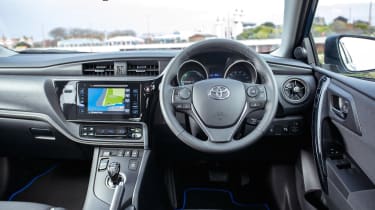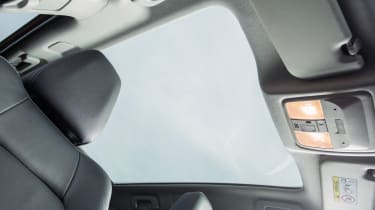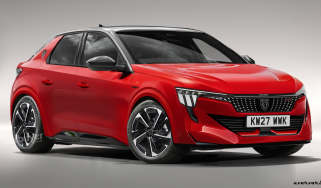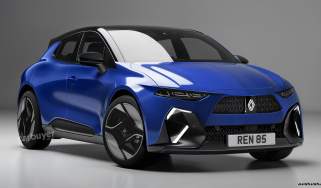Toyota Auris Hybrid (2013-2019) - Interior & comfort
Interior quality is neither offensive nor outstanding, but the Auris Hybrid isn’t as refined as rivals
Inside the Toyota Auris Hybrid, you’re surrounded by robust, tough materials that are likely to stand the test of time, but aren’t exactly inspiring to touch or to look at. Build quality is very good, easily trumping Hyundai or Kia models of the same price, and higher-spec models boast a wider array of textures and finishes for added appeal.
Toyota Auris Hybrid dashboard
The Auris dashboard is an odd visual blend of up-to-date technology and typical Japanese car styling tropes, with recessed dials and ‘eyeball’ air vents at each end. There are some strange touches, too – Toyota’s signature digital clock looks like it comes from another era and is located too far away from the driver to be useful.
Clock aside, the dashboard layout is clear and easy to understand. Where petrol and diesel models have a rev counter, the hybrid has an ‘efficiency’ meter that essentially does the same job, but shows when the petrol engine is operating at its most economical speed. A neighbouring colour TFT screen shows vital statistics like battery range, charge level and fuel consumption.
Equipment
There are four trim levels available: Icon, Icon Tech, Design and Excel. All have the basics that most will use every day, such as automatic air-conditioning, LED daytime running lights, remote control central locking, electric front windows and Bluetooth connectivity.
Icon introduces the Toyota Touch 2 infotainment system, controlled via a seven-inch touchscreen. It offers DAB radio, Bluetooth music streaming and a reversing camera. A set of 16-inch alloy wheels is fitted, too, as are electric rear windows. Most importantly, it includes the Toyota Safety Sense system that’s known to reduce insurance costs.
Move up to Icon Tech for sat nav and cruise control and heated seats. Alternatively, the Auris Design forgoes sat nav in favour of 17-inch alloys, sporty Alcantara suede seat upholstery and privacy glass.
The top-of-the-range Excel model has everything listed above, plus front and rear parking sensors with intelligent parking assistance, enhanced multimedia with 3D maps and voice recognition, automatic LED headlights and automatic wipers.
Options
Where it’s not fitted as standard, Toyota Safety Sense is a must-have feature. It incorporates lane-departure warning, road-sign recognition and auto-dipping headlights. More importantly, it gives you a pre-collision system that can autonomously apply the brakes if a hazard is detected ahead.
Less essential options are a ‘Skyview’ panoramic sunroof (available on the Design model and above), leather upholstery and rear-seat entertainment packages. There are also various iPad holders, boot liners and protection packs available.














